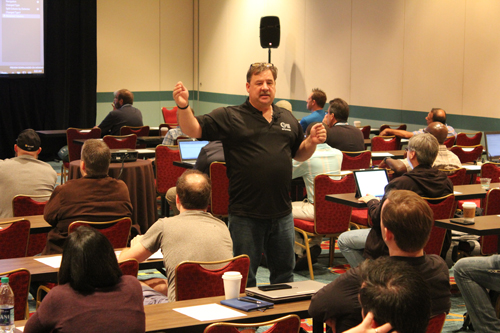Live! 360: Microsoft's 'No. 1 Persona' for BI is the Business User
Partners pitching business intelligence (BI) solutions to business users rather than database administrators (DBAs) appear to have a committed new ally in Microsoft.
When looking at Microsoft's recent enhancements to its BI platforms, the lack of rows, columns and even traditional data management terminology makes it evident that the changes aren't aimed at DBAs.
"Our No. 1 persona, our No. 1 person that we're building for, is the business user," said Charles Sterling, senior program manager in the Microsoft Business Applications Group, during his keynote for the SQL Server Live! track of the Live! 360 conference Tuesday in Orlando, Fla.
Sterling, a 25-year Microsoft veteran, and Ted Pattison of Critical Path Training, delivered the session, "Microsoft BI -- What's New for BI Pros, DBAs and Developers." Their talk centered on demos of Power BI, but also touched on roadmaps for elements of Power BI, and covered the growing role of PowerApps and Flow. The main idea behind PowerApps is to allow business users, without coding, to pull from either simple or complex organizational data sources and create shareable business apps that are usable from mobile devices or in a browser.
All of Microsoft's simplification efforts are driving an explosion of BI usage among organizations. According to a slide from the presentation titled "Power BI by the numbers," there are 11.5 million data models hosted in the Power BI service, 30,000 data models added each day, 10 million monthly publish to Web views, and 2 million report and dashboard queries per hour.
 Charles Sterling, senior program manager in the Microsoft Business Applications Group, discusses Power BI improvements during his keynote for the SQL Server Live! track of the Live! 360 conference Tuesday in Orlando, Fla.
Charles Sterling, senior program manager in the Microsoft Business Applications Group, discusses Power BI improvements during his keynote for the SQL Server Live! track of the Live! 360 conference Tuesday in Orlando, Fla.
Yet one of the biggest obstacles right now preventing business users from running even more wild with the concept is not having access to that organizational data. While a DBA creating a more sophisticated application has, or can quickly get, permissions for the underlying organizational data, the story is different for most business users.
"For [business users] to create an app that goes out and collects data is relatively difficult," Sterling said. "That's what PowerApps is going to enable business people to do in the near future. You can do it right now, but we are actually integrating it into Power BI."
A related concept on the roadmap will actually require more organizational communication across the business, including DBAs educating users to help set expectations. From within their dashboard, business users will be able to use PowerApps to update the database on the back end, a PowerApps roadmap feature called Write Back.
Sterling said the Write Back feature is one of his favorite new features, but he suggested it may be a bit of a struggle for DBAs as business users get going with it.
"For DBAs, empowering business users with the tools to directly update and collect data will likely open a whole new host of problems. Take, for example, a business user updating data being fed into a Hadoop cluster. It is entirely likely that the processing could take hours to days to propagate into the BI system they are viewing. Business users will expect those updates in real time," Sterling said in an interview.
Another big element of the roadmap with business users in mind is storytelling in the Power BI Desktop, Sterling said.
During a demo, Pattison clicked on slicers in a graph within Power BI that were increasing or decreasing. The example application brought up a sentence, based on the underlying data, explaining in business terms what was driving the increase or decrease.
"We're going to continue playing out this whole storytelling [approach]," Sterling said. In another example of such storytelling, Sterling and Pattison ran most of their presentation out of bookmarks in Power BI rather than PowerPoint. The bookmarks recall a preconfigured view of a report page, and pull live data when the bookmark is displayed.
Another demo during the session that caught attendees' attention involved Power BI Report Server, an enterprise reporting solution that received an update release on Nov. 1. Blue Badge Insights Founder and CEO Andrew Brust found the walkthrough of the Power BI Report Server one of the most important demos during the session. "It's an enhanced version of reporting services, but it lets you distribute reports on premises instead of having to push them to the cloud," Brust said.
Sterling said near-term items on the Report Server roadmap include more data sources, more APIs and integration with Microsoft SharePoint.
Posted by Scott Bekker on November 15, 2017